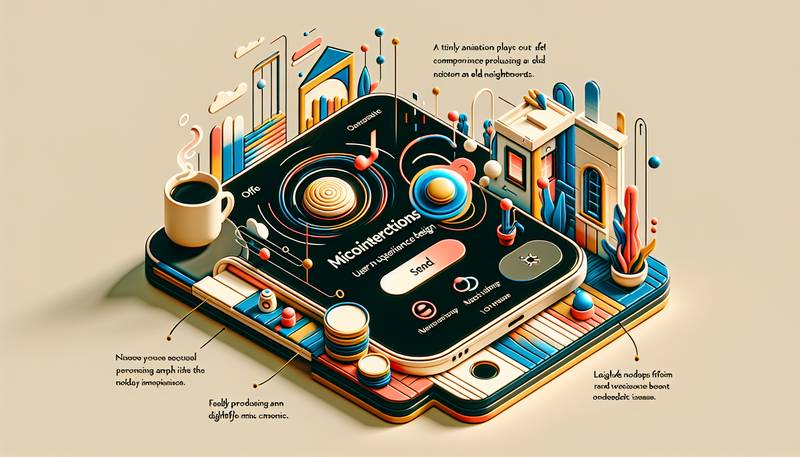Microinteractions: The Subtle Art of UX Design

Small Moments, Big ImpactNothing quite says 'I care' like a well-timed notification sound. Microinteractions are those little moments within applications or websites that, while they might seem inconspicuous, actually shape our entire user experience. Think of them as the friendly nods from an old neighbor—small but reassuringly solid. Whether it's a tiny animation when you hit “send” or a delightful chime when you complete a task, these microinteractions provide feedback and, believe it or not, can boost our mood faster than a hot cup of coffee on a Monday morning.Why They MatterAt first glance, microinteractions may appear trivial. However, they're like the salt in your favorite dish: a little can enhance flavors immensely, while too much can send the whole thing off the rails. They serve three essential functions:- Feedback: Users need to know when they've clicked a button or completed a task. An alert that says, “Yes, you did it!” can do wonders for self-esteem.
- Guidance: A little nudging in the right direction helps users navigate interfaces. Think of it as a GPS that doesn’t shout “recalculating” every time you miss a turn.
- Engagement: Fun animations or delightful sounds can make mundane tasks enjoyable. It’s like finding a cookie in your pocket when you thought you had none, a surprise waiting to brighten your day.
Common Microinteractions Everyone LovesThese small nuggets of delight can be found in daily digital interactions, and understanding them is crucial. Here’s a list of popular ones that users often don't even realize they appreciate:- Loading animations: The little spinny wheel may drive you crazy at times, but we’ve all patiently watched it, hoping for that sweet, sweet notification that our pizza is on the way.
- Button animations: When you click a button and it bounces back like a cheerleader after a successful stunt, it’s hard not to smile.
- Progress bars: Watching that little bar fill up is akin to waiting for dough to rise—full of anticipation and possibly a snack break.
- Sound effects: A tiny 'ding' when you receive a message feels like someone just gave you a virtual high-five.
Creating Effective MicrointeractionsNow that we’re all on the same page about how wonderful microinteractions are, let’s talk about what it takes to create effective ones. Here are some steps to consider, whether you're designing an app or simply trying to impress your cat with your impeccable skills:★ Define the purpose: Every interaction should have a clear function. Don’t give your users a surprise confetti shower every time they delete a file. It’s not a celebration; it’s a tragedy. ★ Be concise: Keep it short and sweet. Users appreciate clarity over a long-winded explanation about why their coffee order has been delayed. ★ Focus on aesthetics: Make it pretty! A microinteraction is like the topping on your beloved sundae; it should enhance the overall experience without overwhelming it. ★ Test and iterate: Just like trying to figure out if the pizza place really puts pineapple on their pies, you won’t know what works unless you keep trying different things and asking for opinions.Falling into the Trap of OvercomplicationWhile microinteractions can be a user’s best friend, an overzealous designer can make them about as pleasant as a wedgie. Overcomplicating these interactions can lead to frustration instead of delight. A freezing screen while your app stumbles through multiple animations is akin to waiting for that overly enthusiastic friend to finish their five-minute story about their cat’s new diet.Keep them simple, engaging, and most importantly, useful. Users should feel like they’ve just opened a surprising packet of gummy bears, not a complex puzzle that requires a Ph.D. in cryptography to solve.A Little Goes a Long WayMicrointeractions are like that secret ingredient in grandma's famous cookie recipe—almost impossible to detect but pivotal to satisfaction. By focusing on making these tiny moments great, designers can create a user experience that feels warm, inviting, and engaging. Users won’t just use the app; they’ll come back for more, like a moth to a flame or a dog to a tennis ball.In the end, while they might be small, microinteractions have the power to transform mundane tasks into memorable experiences. When users feel appreciated and engaged, they are more likely to stick around, making all the little details worth their weight in digital gold. So, when it comes to user experience, remember: it’s the little things that count—after all, who doesn’t love a good surprise?
|
|







